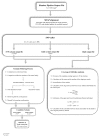Deep sequencing of target linkage assay-identified regions in familial breast cancer: methods, analysis pipeline and troubleshooting
- PMID: 20368986
- PMCID: PMC2848842
- DOI: 10.1371/journal.pone.0009976
Deep sequencing of target linkage assay-identified regions in familial breast cancer: methods, analysis pipeline and troubleshooting
Abstract
Background: The classical candidate-gene approach has failed to identify novel breast cancer susceptibility genes. Nowadays, massive parallel sequencing technology allows the development of studies unaffordable a few years ago. However, analysis protocols are not yet sufficiently developed to extract all information from the huge amount of data obtained.
Methodology/principal findings: In this study, we performed high throughput sequencing in two regions located on chromosomes 3 and 6, recently identified by linkage studies by our group as candidate regions for harbouring breast cancer susceptibility genes. In order to enrich for the coding regions of all described genes located in both candidate regions, a hybrid-selection method on tiling microarrays was performed.
Conclusions/significance: We developed an analysis pipeline based on SOAP aligner to identify candidate variants with a high real positive confirmation rate (0.89), with which we identified eight variants considered candidates for functional studies. The results suggest that the present strategy might be a valid second step for identifying high penetrance genes.
Conflict of interest statement
Figures
Similar articles
-
A 7 Mb region within 11q13 may contain a high penetrance gene for breast cancer.Breast Cancer Res Treat. 2009 Nov;118(1):151-9. doi: 10.1007/s10549-009-0317-1. Epub 2009 Feb 10. Breast Cancer Res Treat. 2009. PMID: 19205878
-
Genome-wide linkage scan reveals three putative breast-cancer-susceptibility loci.Am J Hum Genet. 2009 Feb;84(2):115-22. doi: 10.1016/j.ajhg.2008.12.013. Epub 2009 Jan 15. Am J Hum Genet. 2009. PMID: 19147119 Free PMC article.
-
The genetics of breast cancer risk in the post-genome era: thoughts on study design to move past BRCA and towards clinical relevance.Breast Cancer Res. 2016 Oct 3;18(1):99. doi: 10.1186/s13058-016-0759-4. Breast Cancer Res. 2016. PMID: 27716388 Free PMC article. Review.
-
Whole-genome Linkage Analysis and Sequence Analysis of Candidate Loci in Familial Breast Cancer.Anticancer Res. 2015 Jun;35(6):3155-65. Anticancer Res. 2015. PMID: 26026075
-
A Review of Whole-Exome Sequencing Efforts Toward Hereditary Breast Cancer Susceptibility Gene Discovery.Hum Mutat. 2016 Sep;37(9):835-46. doi: 10.1002/humu.23017. Epub 2016 Jun 27. Hum Mutat. 2016. PMID: 27226120 Review.
Cited by
-
Analysis of positional candidate genes in the AAA1 susceptibility locus for abdominal aortic aneurysms on chromosome 19.BMC Med Genet. 2011 Jan 19;12:14. doi: 10.1186/1471-2350-12-14. BMC Med Genet. 2011. PMID: 21247474 Free PMC article.
-
Whole exome sequencing suggests much of non-BRCA1/BRCA2 familial breast cancer is due to moderate and low penetrance susceptibility alleles.PLoS One. 2013;8(2):e55681. doi: 10.1371/journal.pone.0055681. Epub 2013 Feb 8. PLoS One. 2013. PMID: 23409019 Free PMC article.
-
Identification of rare alleles and their carriers using compressed se(que)nsing.Nucleic Acids Res. 2010 Oct;38(19):e179. doi: 10.1093/nar/gkq675. Epub 2010 Aug 10. Nucleic Acids Res. 2010. PMID: 20699269 Free PMC article.
References
-
- Parkin DM, Bray F, Ferlay J, Pisani P. Global cancer statistics, 2002. CA Cancer J Clin. 2005;55:74–108. - PubMed
-
- Nathanson KL, Wooster R, Weber BL. Breast cancer genetics: what we know and what we need. Nat Med. 2001;7:552–556. - PubMed
-
- Diez O, Osorio A, Duran M, Martinez-Ferrandis JI, de la Hoya M, et al. Analysis of BRCA1 and BRCA2 genes in Spanish breast/ovarian cancer patients: a high proportion of mutations unique to Spain and evidence of founder effects. Hum Mutat. 2003;22:301–312. - PubMed
-
- Oldenburg RA, Kroeze-Jansema KH, Houwing-Duistermaat JJ, Bayley JP, Dambrot C, et al. Genome-wide linkage scan in Dutch hereditary non-BRCA1/2 breast cancer families identifies 9q21-22 as a putative breast cancer susceptibility locus. Genes Chromosomes Cancer. 2008;47:947–956. - PubMed
Publication types
MeSH terms
LinkOut - more resources
Full Text Sources
Medical


